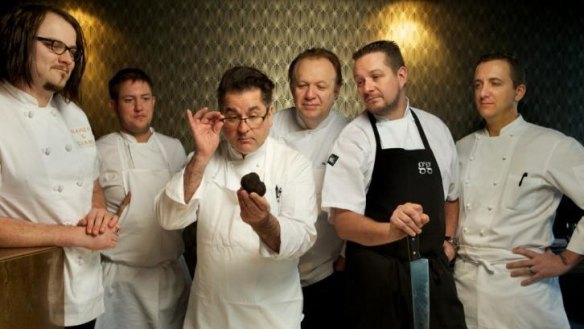Pungent delicacy at root of pleasure at Melbourne Truffle festival

They’re mysterious, grow underground and smell a bit like wet socks. We’re talking truffles, and some foodies pay up to $2500 a kilogram for them.
Now that it is winter these knobbly delicacies - which can be as large as a tennis ball - are in season and appearing on menus around town.
To celebrate and help demystify the odd but tasty fungus, the first Melbourne truffle festival takes place next weekend at Caulfield racecourse.
And a series of satellite events are happening at restaurants and truffieres (truffle orchards) around the state, including a truffle “cook-off” between top chefs Guy Grossi and Philippe Mouchel. Grossi’s simple-but-solid regional Italian approach is up first at Chiara, Docklands, next Friday; Mouchel’s Asian style will be put to the test at GG, in East Melbourne, the following night.
To properly compare cooking techniques you'd need to go to both dinners. But with tickets at $190 a head, perhaps only deep-pocketed truffle tragics need apply.
So, what exactly are truffles? Not to be confused with the delicious chocolate treat, we’re talking about a type of fungi that grows underground from spores attached to hazelnut or oak tree roots. They grow during the summer and ripen in winter, their pungent smell attracting animals such as deer and wild boar that dig them up, eat some and help distribute their spores, which aids reproduction.
Most truffles grown in Australia are Tuber melanosporum, also known as the black truffle, the French black winter truffle or the Perigord truffle. Dogs or pigs are used to detect them through the aid of their pungent smell. The largest truffle in Australia was recently dug out of the Southern NSW Highlands – it weighed in at 1.172 kilograms.
Nigel Wood, festival director of Truffle Melbourne and secretary of the Australian Truffle Growers Association, predicts that in three years Australia will overtake Spain to become the third-largest truffle-producing country in the world, behind France and Italy. While Victoria’s contribution is relatively small (80 per cent of Australian truffles come from Western Australia) it’s here on the east coast that most are consumed.
“The modern science of truffle cultivation is really only about 20 years old,” says Wood, a grower himself who planted 600 mostly oak trees four years ago on his property near Grantville, on Western Port Bay. “There’s still a lot to learn about how it all works and what it is exactly that triggers fruiting.”
Farming truffles is notoriously difficult and Wood knows of at least one truffle grower who planted his crop of inoculated trees 12 years ago without success. (It usually takes about seven years for trees to go into full-production.)
“A lot of people have heard about truffles but they’re not actually that familiar with them,” says Wood, who hopes the festival will educate people about how to cook them as well as how they are grown and harvested. “Some people are scared because they hear they are $2500 a kilogram. But a kilogram would give a truffle feast for 100 people.”
Restaurant reviews, news and the hottest openings served to your inbox.
Sign up